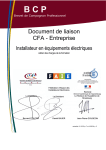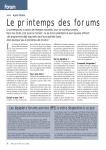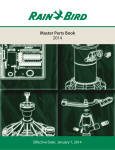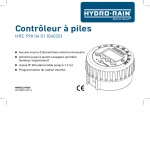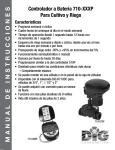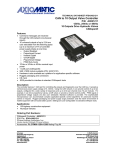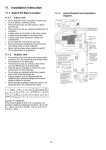Download Commercial Valve Troubleshooting Webinar Valve Cross
Transcript
Commercial Valve Troubleshooting Webinar Harland Hirtzel, Product Manager September 15, 2010 Page 2 September 15, 2010 Valve Cross Sectional View INLET OUTLET 1 Page 3 September 15, 2010 Valve Components FLOW CONTROL SOLENOID COIL PLUNGER VALVE BONNET SOLENOID SEAL DIAPHRAGM PILOT EXHAUST VALVE BODY VALVE SEAL PILOT FILTER VALVE SEAT INLET OUTLET September 15, 2010 Page 4 No Close - Weeping Or Full Open Loose Solenoid Solenoid Example: Gap Is Too Wide Adapter PROBLEM: The solenoid is not fully tightened. The pilot dump line will be constantly open which in turn keeps the valve open. SOLUTION: Tighten the solenoid using the handle/wrench to “hand tight”. 2 Page 5 September 15, 2010 No Close - Weeping Or Full Open Solenoid O-Ring Damage Example: O-ring Is Nicked Solenoid O-Ring PROBLEM: The solenoid o-ring is damaged. Pilot is vented to atmosphere which allows the valve to stay open constantly or intermittently. SOLUTION: Replace the o-ring or replace solenoid assembly. Page 6 September 15, 2010 No Close - Weeping Or Full Open Adapter O-Ring Damage Example: O-ring Is Not In Groove O-Ring PROBLEM: The adapter o-ring is either damaged or installed improperly. The valve pilot is vented to atmosphere which allows the valve to stay open constantly or intermittently. SOLUTION: Replace the o-ring or replace the adapter assembly. 3 Page 7 September 15, 2010 No Close - Weeping Or Full Open Debris on Plunger Seal Example: Debris Has Lodged In Seal Face Plunger Seal Face PROBLEM: Debris has been deposited on the plunger seal face. The plunger cannot seal off the pilot dump hole which keeps the valve open. SOLUTION: Remove the plunger, rinse with water and reinstall. If seal has been damaged, replace the plunger or replace solenoid assembly. Page 8 September 15, 2010 No Close - Weeping Or Full Open Deformed Solenoid Seal Solenoid Bowl Solenoid Seal Good Seal Damaged Seal PROBLEM: The solenoid seal is damaged from over-tightening the solenoid assembly into the solenoid bowl. Even though the solenoid is deenergized, the valve stays open because the pilot exhaust is not sealed off. SOLUTION: Replace the solenoid seal. 4 Page 9 September 15, 2010 No Close - Full Open Missing Parts Example: Solenoid Seal Is Missing Solenoid Adapter White Solenoid Seal Should Be Here PROBLEM: Solenoid seal has been removed. The pilot dump hole cannot be closed and the valve runs full open continuously. SOLUTION: Replace the solenoid seal. Note: Also check for plunger, plunger retainer and spring. September 15, 2010 Page 10 No Close - Weeping Or Full Open Hole Or Crack in Diaphragm Example: Debris Has Cut Hole In Diaphragm PROBLEM: A hole in the diaphragm. On forward flow valves, this hole allows the pressure to equalize on both sides of the diaphragm and keeps the valve open. SOLUTION: Replace the diaphragm assembly. 5 Page 11 September 15, 2010 No Close - Weeping Or Full Open Debris on Plunger Seal Example: Rock Has Been Wedged In Valve Seal Valve Seal Face PROBLEM: Debris has been deposited on the valve seal. This blocks the valve from closing. SOLUTION: Remove debris. If the valve seal (or seat) is damaged or distorted such, replace the entire diaphragm assembly. Page 12 September 15, 2010 No Close - Weeping Valve Seal Pop-Out Example: PEB Valve Seal Has Pulled Away From Support Seal Seal Support PROBLEM: The main valve seal is pulled away from its co-molded plastic support at high pressure and temperature. With the seal cocked to one side, the valve may weep intermittently. Difficult to diagnose because it can correct itself. SOLUTION: Replace the diaphragm assembly. 6 Page 13 September 15, 2010 No Close - Weeping Or Full Open Blocked Pilot Hole/Filter Diaphragm Assembly Viewed From Top Example: Scale Buildup Has Blocked Pilot Hole PROBLEM: Debris or scale has blocked the diaphragm pilot hole and/or filter. This prevents the pressure from equalizing above and below the diaphragm such that it cannot close. SOLUTION: Clean the diaphragm and filter or replace the entire diaphragm assembly. Page 14 September 15, 2010 No Open - Low Or No Flow Blocked/Restricted Pilot Holes Bonnet Body Probe PROBLEM: Debris is blocking one or more of the pilot channels. The valve may only open partially or not at all depending on the severity of the restriction. SOLUTION: Use a thin probe (e.g. paper clip) to clean out the debris. Check both the body and bonnet holes. 7 Page 15 September 15, 2010 No Open - Low Or No Flow Flow Control Misadjusted PROBLEM: The flow control has been manually closed or turned down so low that the valve “dithers”, i.e., cycles open and close quickly. SOLUTION: Fully open the valve and then adjust flow downward until you reach the desired throw on your heads. Then back off ½ turn on the flow control. Page 16 September 15, 2010 Valve Leaks at Adapter Pinched O-Ring Adapter Example: O-Ring Has Been Extruded Out Of Bonnet Bonnet PROBLEM: The o-ring can be damaged if the adapter is not fully tightened into the valve bonnet. Then the o-ring cannot provide a good seal. SOLUTION: Replace the o-ring or replace the entire adapter assembly. 8 Page 17 September 15, 2010 Valve Leaks At Body-To-Bonnet Loose Bolts Or Nuts PGA Valve PEB Valve PROBLEM: The bonnet bolts (or nuts) are not fully tightened down. This results in a poor seal at the body-diaphragm-bonnet interface. SOLUTION: Tighten down the bolts/nuts until the leak disappears. Note: This is also a major cause of no-close symptoms. Page 18 September 15, 2010 Valve Leaks At Body-To-Bonnet Missing Exhaust Port O-Ring Pilot Exhaust Port O-Ring Should Be Here PROBLEM: The o-ring seal between the bonnet and body for the pilot exhaust port is missing. It is sometimes unknowingly lost during servicing. This creates a sizable external leak. SOLUTION: Replace the o-ring. Note: Applies only to PGA Valves. 9 Page 19 September 15, 2010 Valve Leaks At Body-To-Bonnet Misaligned Diaphragm Tab PROBLEM: The diaphragm tab is not lined up with the pilot exhaust port which prevents the diaphragm from sealing in that area. This results in a significant external leak. SOLUTION: Install new diaphragm. Make sure the hole in the tab fits over the exhaust port. Note: Applies only to PEB/PESB Valves. September 15, 2010 Page 20 Valve Leaks At Body-To-Bonnet Misaligned Diaphragm PROBLEM: The outer diaphragm bead has been crushed as a result of not being installed in the groove in the body. This results in a significant external leak. SOLUTION: Install a new diaphragm taking care to make sure the diaphragm bead fits the body grove all the way around the circumference. 10 Page 21 September 15, 2010 Valve Leaks At Stem Extruded O-Ring Seal PROBLEM: The o-ring that seals the flow control stem extrudes out of the bonnet under pressure if misapplied. Water then leaks externally around the stem. SOLUTION: Replace o-ring being careful to lubricate it first. Note: Can also cause no-close symptoms. September 15, 2010 Page 22 Valve Leaks At Inlet Connection Cracked Body PROBLEM: A stress fatigue crack starts at the highest stress concentration point inside the valve and propagates out through the threaded connection. SOLUTION: Replace the valve. 11 Page 23 September 15, 2010 Questions? Page 24 September 15, 2010 Thank You! 12












